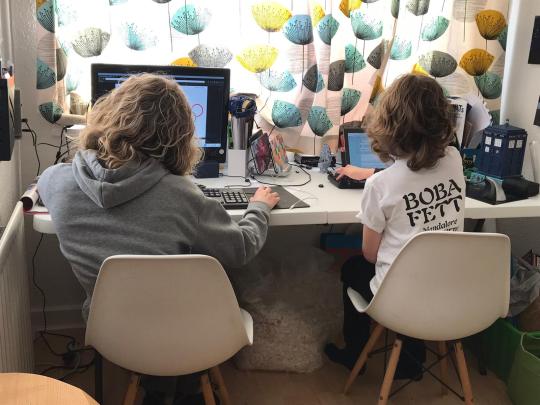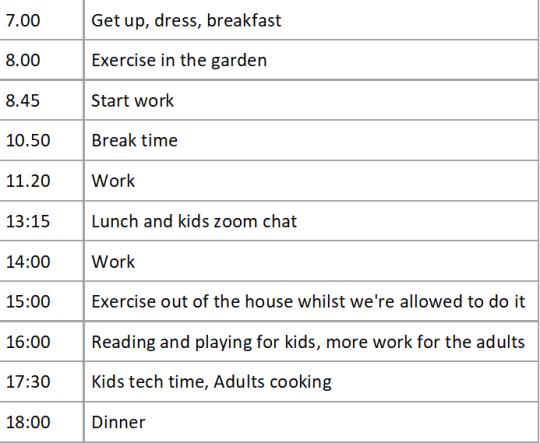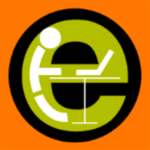Honorable Mention Award @ CSCW 2020
Yoana Ahmetoglu, PhD student at UCLIC, receive an Honourable Mention Award for her paper To Plan or Not to Plan? A Mixed-Methods Diary Study Examining When, How, and Why Knowledge Work Planning is Inaccurate (co-authored with Duncan P Brumby and Anna L Cox)
Talk: Facing the Future: what lessons have we learned?
Prof Anna L Cox gives an invited talk at the Facing the Future: what lessons have we learnt? event to celebrate National Work Life Week 2020.
Remote-work visas will shape the future of work, travel and citizenship

During lockdown, travel was not only a distant dream, it was unlawful. Some even predicted that how we travel would change forever. Those in power that broke travel bans caused scandals. The empty skies and hopes that climate change could be tackled were a silver lining, of sorts. COVID-19 has certainly made travel morally divisive.
Amid these anxieties, many countries eased lockdown restrictions at the exact time the summer holiday season traditionally began. Many avoided flying, opting for staycations, and in mid-August 2020, global flights were down 47% on the previous year. Even so, hundreds of thousands still holidayed abroad, only then to be caught out by sudden quarantine measures.
In mid-August for example, 160,000 British holiday makers were still in France when quarantine measures were imposed. On August 22, Croatia, Austria, and Trinidad and Tobago were added to the UK’s quarantine list, then Switzerland, Jamaica and the Czech Republic the week after – causing continued confusion and panic.
This insistence on travelling abroad, with ensuing rushes to race home, has prompted much tut-tutting. Some have predicted travel and tourism may cause winter lockdowns. Flight shaming is already a cultural sport in Sweden, and vacation shaming has even become a thing in the US.
Amid these moral panics, Barbados has reframed the conversation about travel by launching a “Barbados Welcome Stamp” which allows visitors to stay and work remotely for up to 12 months.
Prime Minister Mia Mottley explained the new visa has been prompted by COVID-19 making short-term visits difficult due to time-consuming testing and the potential for quarantine. But this isn’t a problem if you can visit for a few months and work through quarantine with the beach on your doorstep. This trend is rapidly spreading to other countries. Bermuda, Estonia and Georgia have all launched remote work-friendly visas.
I think these moves by smaller nations may change how we work and holiday forever. It could also change how many think about citizenship.
Digital nomads
This new take on visas and border controls may seem novel, but the idea of working remotely in paradise is not new. Digital nomads – often millennials engaged in mobile-friendly jobs such as e-commerce, copywriting and design – have been working in exotic destinations for the last decade. The mainstream press started covering them in the mid-2010s.
Fascinated by this, I started researching the digital nomad lifestyle five years ago – and haven’t stopped. In 2015, digital nomads were seen as a niche but rising trend. Then COVID-19 paused the dream. Digital nomad Marcus Dace was working in Bali when COVID-19 struck. His travel insurance was invalidated, and he’s now in a flat near Bristol wondering when he can travel.
Dace’s story is common. He told me: “At least 50% of the nomads I knew returned to their home countries because of CDC and Foreign Office guidance.” Now this new burst of visa and border policy announcements has pulled digital nomads back into the headlines.
So, will the lines between digital nomads and remote workers blur? COVID-19 might still be making international travel difficult. But remote work – the other foundation of digital nomadism – is now firmly in the mainstream. So much so that remote work is considered by many to be here to stay.
Before COVID-19, office workers were geographically tethered to their offices, and it was mainly business travellers and the lucky few digital nomads who were able to take their work with them and travel while working. Since the start of the pandemic, many digital nomads had to work in a single location, and office workers have become remote workers – giving them a glimpse of the digital nomad lifestyle.

© Dave Cook and Tony Simonovsky, Author provided
COVID-19 has upended other old certainties. Before the pandemic, digital nomads would tell me that they despised being thought of as tourists. This is perhaps unsurprising: tourism was viewed as an escape from work. And other established norms have toppled: homes became offices, city centres emptied, and workers looked to escape to the country.
Given this rate of change, it’s not such a leap of faith to accept tourist locations as remote work destinations.
A Japanese businessman predicted this
The idea of tourist destinations touting themselves as workplaces is not new. Japanese technologist Tsugio Makimoto predicted the digital nomad phenomenon in 1997, decades before millennials Instagrammed themselves working remotely in Bali. He prophesied that the rise of remote working would force nation states “to compete for citizens”, and that digital nomadism would prompt “declines in materialism and nationalism”.
Before COVID-19 – with populism and nationalism on the rise – Makimoto’s prophecy seemed outlandish. Yet COVID-19 has turned over-tourism into under-tourism. And with a growing list of countries launching schemes, it seems nations are starting to “compete” for remote workers as well as tourists.
The latest development is the Croatian government discussing a digital-nomad visa – further upping the stakes. The effects of these changes are hard to predict. Will local businesses benefit more from long-term visitors than from hordes of cruise ship visitors swarming in for a day? Or will an influx of remote workers create Airbnb hotspots, pricing locals out of popular destinations?
It’s down to employers
The real question is whether employers allow workers to switch country. It sounds far-fetched, but Google staff can already work remote until summer 2021. Twitter and 17 other companies have announced employees can work remotely indefinitely.
I’ve interviewed European workers in the UK during COVID-19 and some have been allowed to work remotely from home countries to be near family. At Microsoft’s The New Future of Work conference, it was clear that most major companies were mobilising task forces and would launch new flexible working policies in autumn 2020.
Countries like Barbados will surely be watching closely to see which companies could be the first to launch employment contracts allowing workers to move countries. If this happens, the unspoken social contract between employers and employees – that workers must stay in the same country – will be broken. Instead of booking a vacation, you might be soon booking a workcation.![]()
Dave Cook, PhD Researcher, Anthropology, UCL
This article is republished from The Conversation under a Creative Commons license. Read the original article.
Boundary Management and Communication Technologies
Marta E. Cecchinato and Anna L. Cox have published a chapter titled Boundary Management and Communication Technologies in The Oxford Handbook of Digital Technology and Society.
Abstract
We live in a world of communication overload, where there is a wide range of platforms and devices to choose from, each providing massive content, offering different affordances, and fighting for our attention. Mobile technologies have contributed to expectations of anywhere anytime connectedness, making it hard for individuals to switch off. As a result, it can be hard to feel truly disconnected from work. A lack of control over work-home boundary cross-overs and interruptions can reduce post-work recovery, reducing productivity and increasing stress. Technology is not inherently good or bad, but rather, the way it is adopted and used can positively or negatively color one’s experience. As such, in this critical review we take a social constructionist approach to emphasize how communication technologies are challenging, as well as supporting, work-home boundary management. In doing so, we bring together work from occupational psychology (boundary theory) and human-computer interaction (computer-mediated communication and cross-device interaction). Understanding how these aspects interact and influence each other is important in order to support individuals appropriately, inform policies and guidelines, and ensure both social and digital interactions are designed carefully.
Five workplace trends will shape life after lockdown

We are experiencing the biggest remote work experiment in history – but many are beginning to imagine life after lockdown. Amid unprecedented global job losses, concerns about transport infrastructure and the continuing need for workplace social distancing, governments are launching back-to-work plans.
Meanwhile, the latest US research reveals that 74% of businesses want some workers to permanently work remotely and business leaders are actively shedding leased office space – hinting that not everyone will go back to the office.
Here are five key trends that will shape the future of how we work.
1. Commuting will change forever
We might miss the social interaction of the office, but most don’t miss commuting. This was one of the key findings in my four-year remote work study.
Before lockdown, US commute times reached record levels and most UK workers spent more than a year of their lives travelling to and from work. People tell me that a hybrid strategy of working from home two days a week, is one ideal scenario.

Shutterstock
Those eager to go back to the office will have to wait. Many will need to work from home for weeks or months to come. The situation is fluid, but governments are drawing up plans for workers to stagger working times, so public transport is not overwhelmed.
The genie is out of the bottle, and commuting is not going back to how it was.
2. Bad email etiquette won’t be tolerated
Workplace communication is rapidly transforming and email is a case in point. More than ever, creating a clear separation between work and leisure time is vital.
Research repeatedly shows that sending out-of-hours emails is not only bad etiquette – but creates a coercive work culture that requires people to be available 24/7. Social scientists argue this turns us into worker/smartphone hybrids and causes stress and burnout. Expecting quick answers to email is increasingly seen as bullying.
Many now realise that colleagues might need to work flexibly due to caring responsibilities. Lockdown has encouraged a new acceptance of flexibility. But this shouldn’t extend to having a culture that expects people to be available all the time.
3. Video calls will be limited
Zoom calls will remain part of our lives – but we will change and adapt how we use them. Research shows that video calls are more draining and tiring than in-person meetings.

Shutterstock
While video calls are appropriate for some meetings, we don’t need to use them for all our communication. Research suggests many are shifting back to phone calls – which as one manager explained to me “feels more spontaneous and flows better”.
4. More co-working spaces will emerge
Workers forced to continue working from cramped living spaces are desperate for alternatives. When lockdown lifts they will turn to the cafes and co-working spaces that are still in business. Before COVID-19 hit, co-working spaces were projected to increase more than 40% worldwide.
The paradox of remote working is that people crave the flexibility but know that being around others boosts productivity. My research shows that over time remote workers crave the physical closeness that comes with just being alongside other people. It’s exactly why in 2017 IBM pulled many employees back into the office, despite having previously published a 2014 white paper in support of remote working.

Shutterstock
Local co-working spaces, as opposed to big investor-funded brands such as WeWork, will do well. Independent co-working spaces in some areas were thriving before COVID-19 – they may become more mainstream if they survive lockdown.
5. Could we become part-time digital nomads?
Digital nomads are extreme remote workers that post Instagram stories from exotic locations. Right now, that lifestyle seems unrelatable, impossible and to many unethical.
Nonetheless, many decently paid workers in New York, London and Paris are stuck in uncomfortably small flats, dreaming of escape from lockdown. As a housing manager recently confided to me: “London living without nightlife and culture, isn’t fun. Everyone wants to escape to somewhere outdoorsy when allowed. I’m not sure I approve but it’s understandable.”
For now, remote working from different locations is not allowed. But the allure of relocating to a picturesque location remains – and Brian Chesky, CEO of AirBnB, is banking on it. He sees COVID-19 as a business opportunity and told Bloomberg: “People are realising they can work remote … that’s a huge opportunity.”
Not all will agree – it could cause long-term sustainability issues – and many will not have this privilege. But when lockdown fully lifts, who’s to say more people will not work remotely from different parts of the world, beyond their living rooms.![]()
Dave Cook, PhD Researcher, Anthropology, UCL
This article is republished from The Conversation under a Creative Commons license. Read the original article.
You are suddenly part of a virtual team.
Reblogged from an article by Evelyn Tan describing our work on using games to support the creation of digital teams
We were pushed into the age of fully remote work as abruptly as COVID-19 exploded across the globe. We are all suddenly part of a virtual team. We had no idea this was coming. And to be honest, it doesn’t seem like remote work is going to go away after things go back to “normal”.
Organisations are still scrambling to figure out how to deal with the ramifications of virtual work.
On the other hand, managers and team leaders are trying to figure out how to best keep their teams afloat.
But here’s some good news: Research on virtual teams — the challenges they face and how to make them effective — has been around since the Internet became a thing.
In this article, I highlight some of the most pressing challenges that you are going to face (or admittedly, have already faced) now that you are part of a virtual team. These challenges are primarily related to team processes — how do we get things done. I will also highlight some actionable solutions, based on scientific literature.
This article is meant for teams who are clear on their purpose, goals and roles but are struggling to set the right processes in place to achieve them. Without the former, the latter won’t get you anywhere.
Fun fact. Virtual work or remote work is also known as ‘telecommuting’, to refer to work where commuting time is reduced.
Problem 1: You can’t monitor your team. Trust is essential.
An effective virtual team requires a lot of trust because there is an increased sense of uncertainty. Since you cannot see people physically, you cannot monitor them like you previously could when co-located. If you micromanage, you will be exhausted, your colleague will be annoyed, and everyone becomes less productive. You need to trust that everyone has the team’s best interest in mind.
I like this definition of trust by Wilson, Straus and McEvily (2006, p.3)
Trust is the confident positive expectations about the conduct of another
The whole team becomes more productive when there is trust because less time will be spent checking up on each other and making contingency plans. We can have confidence that our team members will deliver on time.
Assuming that everyone is clear on their roles and their goals, how can we be confident that people are actively working towards them?
Solution: Encourage predictable communication through substaintial and timely responses.
In situations with high uncertainty, one way to build trust is to provide a lot of reasons to warrant trustworthiness. For virtual teams, this means exhibiting communication behaviours that give people a reason to trust you.
In an early study on the initial and final trust levels of global virtual teams, teams that were characterised as “high initial and high final trust” exhibited enthusiasm and excitement in the beginning and sustained frequent communication. Communication was not strictly task-focused but also included social content (i.e. things about their life outside of work).
This shows that teams with high levels of trust get there because they spend time developing all aspects of trust — trust based on rational reasons (e.g. Peter has always delivered his work on time) and trust based on emotional ties (e.g. Peter genuinely cares about my well-being).
Having substantial communication and timely responses helps to build up a history of reciprocal, positive interactions. The more actions someone has performed, the easier it is to predict or approximate their future behaviours. This feeds into our perception of their trustworthiness, which gives us confidence in our team members even if we do not see them. But this doesn’t mean we should be flooding the chat. Rather, our responsiveness should signal that we remain committed to achieving our goal.
The key point to remember is that trustworthiness is a function of prior successful ‘trust transactions’. Therefore, for new virtual teams, having substantial communication provides opportunities to validate trust, and timely responses strengthen perceptions of trustworthiness. As the team develops, less frequent communication is needed to maintain trustworthiness.
Problem 2: The way we interact with our team is going to change. Set guidelines for behaviour.
Spatial separation affects how team members interact with one another. Since the ability to walk up to a colleague and have a face-to-face conversation is suspended, interactions will become more effortful and less fluid. As shown in this study, this means that we can expect lags in information exchange, a higher chance of misunderstandings, and fewer attempts to seek information.
Since communication is asynchronous, it can also become overwhelming — if you’ve ever missed a text conversation that you are not an active participant of only to come back to 100 unread messages, you’ll know how this feels. A flurry of text chat, and endless back-scrolling could have been avoided through a simple phone call.
Solution: Use the right communication channel. Establish norms of functioning
Choose an appropriate communication channel. Effective virtual teams match the communication channel to the function of the interaction, or the task at hand. More complex tasks would require channels that allow higher synchronicity. For example, if the point of the interaction is to have a discussion that involves resolving previous ambiguities, brainstorming and problem solving, with a decision at the end, a video call is most appropriate as lags in information exchange are likely to be counterproductive. Having this interaction over text chat would be overwhelming. On the other hand, if the point of the interaction is to gather information, using email, text chat and phone calls will suffice.
Establish norms of functioning. Norms are particularly important in situations with high uncertainty (i.e. virtual teams) because it provides guidelines on how to behave. For virtual teams, establishing a guideline for how the team should function helps to regulate communication and work.
Day-to-day functions.
It is important to establish norms related to monitoring progress because there will be high ambiguity on what is appropriate behaviour. For example, everyone should be clear on how often to check and respond to messages. Everyone should also be clear on how often to provide status updates and check on other member’s status. By explicitly setting these norms, these behaviours are seen as necessary for team success, not because of paranoia or a lack of trust. On the plus side, research shows that trust is built when people adhere to norms.
Team meetings.
Ensure everyone has a chance to speak and contribute. High-performing teams are marked by equally distributed communication, virtual or not. When it is their turn, do not cut anyone off. Give people ample time to speak. As found in a study on predicting cohesion in virtual team meetings, the pause time between a person’s turn and the same person’s next turn was predictive of highly cohesive teams. This means that everyone should have a turn to speak and be given time to talk. If anyone is dominating the conversation, reel them back and encourage others to chip in.
It is also important to encourage people to be actively involved in the meeting, even if they are not speaking. The same study found that cohesion can be predicted most accurately by the amount of visual activity a person exhibits when they are not speaking. Gestures like nodding, for example, signal active listening. In video calls, where virtual team meetings likely take place, everyone can be seen head-on. This means that it is easy to tell who is listening and who isn’t. Norms should be established around engagement and participation in virtual team meetings.
Problem 3: Everybody is going to feel more distant. Invest time in team bonding.
When we are co-located, interpersonal relationships develop through spontaneous interactions with our colleagues. There are intentional interactions as well, but the ‘random chats’ and ‘coffee breaks’ are actually crucial to developing bonds. It has been found to increase cohesion and productivity.
When teams become virtual, there is no more water cooler to congregate around. Since communication is more effortful, it can be heavily task-focused and less about the social lives of others. If your team members do not already have strong interpersonal relationships, virtual work can make them feel more distant from their colleagues.
Solution: Make time for social chat and play video games together.
In the current climate, it can be easy to just make virtual everything that we used to do in a co-located space. Virtual Friday night drinks and virtual pub quizzes are the go-to post-work activities. These activities usually take place over a video call, but as the world has come to realise, conducting typically co-located experiences through a screen is exhausting. Using the same virtual space for work and fun doesn’t provide enough separation. If people are on the same platform that they use to do work (e.g. Zoom, Teams, Skype), with work-related people (i.e. colleagues) but doing an activity that is not work-related, it might not create enough mental distance for recuperation — social activities will still feel like work.
So, consider playing a video game instead.
By this, I mean games where everyone is represented as an avatar in a virtual world, and video call is not required. ‘Zoom Fatigue’ has become a thing and is so taxing on our brain because video calls require greater attentional effort and make us feel more self-conscious. Playing video games together, on the other hand, is a shared activity that lets people truly wind down. And there are several reasons why.
Video games are unique because they are immersive experiences — they draw people into the game and make them momentarily forget what’s happening in the real world. So it’s no surprise that digital games have been found to aid post-work recovery. And one of the reasons is because it helps people to detach both physically and mentally from work.
Video games are also completely different virtual environments. Everyone is likely represented as an avatar that does not resemble their ‘real world’ selves. People can embark on activities that they do not usually do in their day-to-day.
Video calls are also not required — using ‘voice chat’ over Discord is the preferred method for gamers. This means that nobody will feel conscious about how they look, or about people looking at them.
Finally, you will be engaging in an activity that is inherently built for fun and enjoyment. The whole interaction has nothing to do with work and everything to do with the social experience.
So it’s no surprise that video games have been found to support deep social relationships. The game provides opportunities for shared experiences which becomes a catalyst for conversation. Bonds are formed over the experience and we learn more about the people we work with, beyond the work that they do.
Don’t know what to play? Here are a couple of 4-player team-based games that I’ve really enjoyed playing with my friends. They are easy to learn, easy to set up and don’t have high system requirements.
- Lovers in a Dangerous Spacetime (local co-op only)
- Unrailed! (online co-op)
Tying it all together.
To develop an effective virtual team, conscious and intentional effort is required. The three main challenges that virtual teams face are:
- difficulty in monitoring performance
- learning how to interact through computer-mediated mediums
- overcoming feelings of distance
In this article, I’ve highlighted how these challenges can be addressed. By focusing on developing trust, developing norms of functioning and developing social bonds, the foundation for virtual team effectiveness can be built.
Digital work-life Boundaries for when you’re working from home
Prof Anna L Cox talks to Andrew Kun and Orit Shaer about Digital work-life Boundaries for when you’re working from home on their Future of Work Conversations webinar
The Psychology of Successfully Working from Home
Prof Anna L Cox talks to Prof Joe Devlin from UCL Changing Minds about The Psychology of Successfully Working from Home
I’ve lived through many disasters. Here is my advice on “productivity”.
Great twitter thread from Dr Aisha Ahmad which I’ve unrolled here
@ProfAishaAhmadInt’l Security prof @UTSC & @UofT, Chair WIIS-Canada, boxer. Author of award-winning book Jihad & Co. https://bit.ly/2uqQVWD
Academic peeps: I’ve lived through many disasters. Here is my advice on “productivity”. First, play the long game. Your peers who are trying to work as normal right now are going to burn out fast. They’re doomed. Make a plan with a longer vision. /1
Second, your top priority is to stabilize and control your immediate home environment. Ensure your pantry has sensible supplies. Clean your house. Make a coordinated family plan. Feeling secure about your own emergency preparedness will free up mental space. /2
Third, any work that can be simplified, minimized, and flushed: FLUSH IT. Don’t design a fancy new online course. It will suck & you will burn out. Choose the simplest solution for you & your students, with min admin. Focus on getting students feeling empowered & engaged. /3
Fourth, give yourself a proper mental adjustment window. The first few days in a disaster zone are always a write-off. But if you give yourself that essential window, your body and mind WILL adjust to the new normal. Without that mental shift, you’ll fall on your face. /4
Fifth, AFTER you experience the mental shift, build a schedule. Make a routine. Put it on a weekly calendar with time blocks. Wake up early. Put the most important parts first: food, family, fitness. Priority 1 is a stable home. Then add windows for achievable work goals. /5
Sixth, cooperate with your brain. For me, I need to ease into heavy-duty academic writing. So I do admin in the morning, and then dip my toe into papers and book projects around noon. Tick off accomplishments, no matter how small. Trust and support your mental shift. /6
It’s unreasonable to demand your body & brain do the same things under higher stress conditions. Some people can write in a war zone. I cannot. I wait until I get back. But I can do other really useful things under high stress conditions. Support your continuing mental shift. /7
For my PoliSci colleagues: this phenomenon should change how we understand the world. So let this distract you from your work. Because the world is supposed to be our work. May this crisis dismantle all our faulty assumptions and force us into new terrain. /8
And finally, we can check on our neighbours, reach out to isolated people, and volunteer or donate as we can. Because at the end of the day, our papers can wait.
What crowdworkers can teach us about working at home
As schools across the UK closed their doors on Friday families focused on how they were going to create a coworking space at home. They spent their weekend moving furniture, clearing out spare rooms, refinding extension cable usually reserved for the xmas tree lights so as to create a new home office that could fit the whole family. We are fortunate enough to have a small extension that is open plan to our dining room that we can fit 3 of us into and we’ve squeezed an extra deskspace on the edge of the dining room so that we each have our own place to work.

My new coworkers include a teen, a tween who are used to spending their days at school and doing a bit of homework at the end of the day. The fourth member of our team is a middle-aged man who is used to getting most of his ‘deep-work’ done in the office, and only using home for catching up on email. None of them are happy to be here! I, on the other hand, am used to having the place to myself to get on with ‘deep work’ and use my office for face to face meetings. I’ve been working at home for at least a day a week (usually more) for the last 16 years, first motivated by avoiding the crazy costs of commuting into London and then to facilitate the juggling of school pick-ups that comes with family life.
Our new normal means scheduling our day around the timetable of a secondary school. They’re encouraging the teen to do the work set during standard lesson time and of course that’s completely necessary for live online lessons. The tween is doing a fantastic job of following the lesson plans that have been emailed over by his teacher this morning. And I’ve realised that this timetable isn’t that different that one I followed on a writing retreat last year so this might actually work well for all of us. I don’t often take a 20 minute break in the middle of my morning but it was lovely to stand out on the patio in the sunshine whilst having a cup of tea.

We all have different needs in this space. Two of us have online meetings with work colleagues and students, as well as video lectures to record. The teen is in the middle of an online lesson in google meets as I type – it seems that he doesn’t have to say anything (thank goodness) but I can still just about hear the teacher’s voice from his headphones. Being physically all in the same space isn’t going to work for all hours of the day so meetings and lecture recordings are going to have to be made from bedrooms. Connecting socially online is also important now we are distancing ourselves physically from everyone else and the kids need time to talk to their friends so we’ve set up daily meetings for them with online conferencing software so that they can hang out together.
We’re also trying to follow the WHO guidelines that state that children and youth aged 5–17 should accumulate at least 60 minutes of moderate- to vigorous-intensity physical activity daily https://www.who.int/dietphysicalactivity/factsheet_young_people/en/ Walks and runs around our local streets and park involve taking swerving routes away from people who don’t seem to have worked out that moving into single file when you are coming face to face with someone is probably a good idea! Yesterday a group stopped still as they saw us coming towards them – all 4 of them stood side by side across the path!
In this new coworking world, the research I’ve been doing with my PhD student Laura Lascau into the environments in which remote crowdworkers do their work has taken on new personal significance. There are many parallels between the challenges experienced by crowdworkers and those that many families will find themselves facing this week and I’ve tried to take on board what we have learnt when designing our new coworking arrangements. In the rest of this post I’ll summarise some of the findings from a paper we published last year and what we can learn from them:
Laura Lascau, Sandy J. J. Gould, Anna L. Cox, Elizaveta Karmannaya, and Duncan P. Brumby. 2019. Monotasking or Multitasking: Designing for Crowdworkers’ Preferences. In Proceedings of the 2019 CHI Conference on Human Factors in Computing Systems (CHI ’19). Association for Computing Machinery, New York, NY, USA, Paper 419, 1–14. DOI:https://doi.org/10.1145/3290605.3300649 (The full paper is available open access here https://discovery.ucl.ac.uk/id/eprint/10066164/1/1.%20monotasking-multitasking-CHI2019.pdf )
We surveyed people who work from home regularly about what works for them and have been able to extract some helpful tips for others that find themselves in this situation now.
Making an office space
What changes would crowdworkers make to their spaces? Here are the top 4 things that they felt would improve their home work space.
- multiple monitors – our participants were clear that having multiple monitors would help them to get their work done more easily rather than working only from a small screen.
- have designated office spaces – they were also big fans of having a designated office space to work in. We pick up on this below when considering working around other people
- more comfortable chairs – having to made do with a corner of the sofa, or someone’s bed as a workspace was common. Having a comfortable chair was see
- larger desks – having a space to lay out everything they needed to complete their work was important

Working around other people
What are the most common challenges to focusing on work at home?
- presence of other people
- having the TV on
- pets
- digital distractions
About 40% of our participants worked from a shared space and struggled with integrating their demands of the different types of work they do with the constraints of their physical environment. As one of our participants told us:
“I would first and foremost move it into a private room. I miss out on numerous [jobs] because I am unable to record audio or video due to the fact others are making noise around me or would be in the webcam video. It also provides many distractions since it’s in the front room. A personal private room would be the best upgrade.”
Tip: Find out from everyone what kinds of activities they need to do in their day in order to identify what kind of spaces you need. Are you able to provide everyone with their own working space? If not, do you need a quiet working space for those doing ‘deep work’ and another place where people can have online meetings? Is this going to work every day or do you need to agree to rotate around? Check in frequently with each other to make sure everyone is getting the type of space they need.
Managing distractions
What helps workers focus on their work?
- quiet spaces,
- limited distractions,
- background entertainment (mainly listening to music)
Our participants told us about the strategies they use to manage distractions that come from other people:
“I use noise cancelling headphones. I tune out environmental noises or activities. I remain focused on what I’m doing. I do not engage in more than one activity at a time unless the [the work] require me to do so. I do not eat or listen to music while I work. I tend to work when the environment is calm rather than when I know those around me will be active.”
“I try to work during times I know the kids are being independent or napping.”
Tips: Sharing your work space with people who are prone to interrupt you is always difficult. Agreeing on a daily schedule that everyone agrees to might be helpful for helping to plan when you’re going get your work done. Remember that everyone feels that their own work is important so you can’t have one person dominating the way the space is being used. There’s going to have to be a lot of compromise.
If you have young children then talk to them about what they can be doing whilst you get on with your work. Some children can get lost in a book or happily play for hours with their toys. Most children can be occupied by tv or digital games. If you can, stick on some headphones and power through! Perhaps young children could be entertained by grandparents through videoconferencing software – they could read stories to them, or have a chat.
Work-life boundary management and leisure time
People vary in terms of how they tend to manage their work-life boundaries. Some people prioritise work, others non-work, and some try to do both. People also vary in terms of how separate they like to keep these parts of their lives: ‘integrators’ are happy switching frequently between one and the other, perhaps to the point where these doesn’t seem to be a boundary at all. ‘Separators’ like to keep them completely separate and wouldn’t ever contemplate working at home or at the weekend.
It won’t come as a great surprise to know that we saw that people who work from shared spaces such as family homes experience a far greater number of interruptions from personal matters when they were trying to work than those who were working from private spaces.
Tips: If you or your partner are separators then recognise that you’re likely to find this new co-working environment challenging and that it will take time to adapt to it. Again a schedule can be helpful here so that you block time for work and time for non-work. Remember to schedule non-work activities whether that’s time with friends, taking part in an online “pub” quiz or one of the many online exercise classes that have suddenly appeared.

